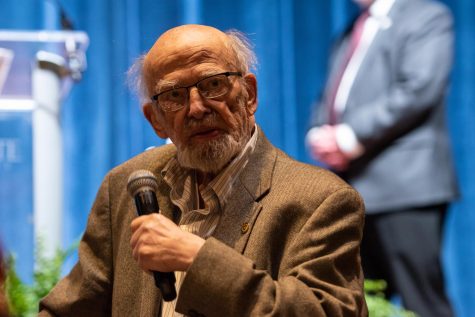Sound lights up the screen
December 8, 2005
People with hearing loss can benefit from new technology
Learning to speak correctly when you cannot hear the sound you are making is difficult.
Using technology, speech pathologists now have a way to show people with hearing impairments what those sounds look like.
Anna Schmidt, coordinator for the English Language Proficiency Clinic at Kent State, sits in front of a computer monitor as she demonstrates how she uses a palatometer with her clients.
Wearing a mouthpiece made for her by an orthodontist, Schmidt begins speaking.
“Eeennnn.”
The computer screen lights up with small blue dots, showing her the sounds she is making by flickering and reappearing with each nuance in her voice.
“Eeessss.”
Attached to her mouthpiece is a shimmering gold strip of electrodes that are relaying information through a small, black box hanging from a cord draped around her neck, which then goes into the computer.
Because the mouthpiece lays against the roof of her mouth, every time Schmidt touches her tongue to it, the sensors note the change. The dots on the screen correlate to the dotted electrodes in the mouthpiece, and reform according to the way Schmidt changes the shape of her mouth.
All but a few consonant sounds in the English language require the tongue to touch the roof of the mouth, Schmidt said.
“It’s teaching someone what to do with their tongue that they never could figure out,” Schmidt said of the palatometer.
“There are kids who can’t learn with traditional methods, so visual feedback usually works for them,” she said
Philip is one of the children who has worked with Schmidt and the palatometer.
Diagnosed with hearing loss at the age of 3, Philip has virtually no hearing in one ear and some loss in the other, said audiologist Carol Sommer, director of the Speech and Hearing Clinic at Kent State.
“One problem was his intelligibility,” said his mother, Pamela Tontodonato, undergraduate coordinator in the Department of Justice Studies.
In a coordinated effort involving the Audiology and Speech Center at the University of Akron, the Speech and Hearing Clinic at Kent State and Philip’s school, he quickly acquired new skills, Sommer said.
Although he made rapid progress using traditional speech therapy after getting hearing aids, there were still sounds Philip could not hear and could not reproduce, said Shelley Francis, a speech pathologist and clinical supervisor at the Speech and Hearing Clinic.
They referred him to Schmidt, who worked with Philip using the palatometer.
Pronouncing the letter “s” requires that you form a very narrow channel down the center of the mouth. Philip was making his a little further back, Schmidt said.
“I can see what he’s doing, but then I can also teach him to do it correctly,” she said.
Philip, now 8 years old, recalls using the palatometer.
“It felt weird to have it in my mouth. Whenever I spoke, it came up on the screen,” he said.
Find more information about the palatometer and the field of speech pathology it has launched, palatometry, at www.LogoMetrix.org.
Contact College and Graduate School of Education, Health and Human Services reporter Theresa Montgomery at [email protected].























